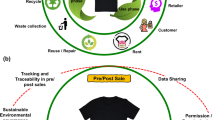Abstract
This research explores the role of digitally enhanced apparel in encouraging empathic linkage between geographically distant individuals. The research draws from the diverse fields of communications theory, neuropsychology, presence technologies and technologically advanced textiles, and suggests that a nexus of these disciplines may provide significant opportunities for enhancing the user interactivity of garments. The paper then describes a series of prototypes that the author has developed, in collaboration with a fashion designer and electronic engineers, to encourage remote empathic connection through the real time transference of heartbeat. The paper concludes with a brief discussion regarding what has been learnt through the design and development process, particularly the difficulties in bridging theory and practice, and the role of design in the development of wearable electronics projects.



Similar content being viewed by others
References
Axisa F, Dittmar A, Delhomme G (2003) Smart clothes for the monitoring in real time and conditions of physiological, emotional and sensorial reactions of human. Paper presented to the 25th annual international conference of the IEEE engineering in medicine and biology society, Cancun, Mexico, 17–21 September
Carpenter E, McLuhan M (eds) (1970) Explorations in communication. Jonathan Cape Ltd, London
Greene R (2004) Internet art. Thames & Hudson, London
Jothi D (2003) Wearable electronics. Proceedings of the international conference on electrical and computer engineering (ICECE), Bahir Dar, October 29th–November 1st
Lehmann U (2000) Tigersprung: fashion in modernity. MIT, London
Manovich L (2001) The language of new media. MIT, Cambridge
Mark W (1999) Turning pervasive computing into mediated spaces. IBM Syst J 38(4):677–692
McHale J (2002) Wearable computers help make individual soldiers part of the digital battlefield. Military and aerospace electronics. Accessed 13/06/2005. http://mae.pennnet.com/Articles/Article_Display.cfm?Section=Archives&Subsection=Display&ARTICLE_ID=148205&KEYWORD=wearable%20electronics
McHale J (2004) Wired and ready to wear. Military and aerospace electronics. Accessed 13/06/2005. http://mae.pennnet.com/Articles/Article_Display.cfm?Section=Articles&Subsection=Display&ARTICLE_ID=215491
McLuhan M (1994) Understanding media: the extensions of man. MIT, Cambridge
Milne E (2004) Email and Epistolary technologies: Presence, Intimacy, Disembodiment. Fibreculture, issue 2—new media, new worlds. Accessed 06/09/2004. http://journal.fibreculture.org/issue2/issue2_milne.htm
Nasoz F, Alvarez K, Lisetti C, Finkelstein N (2003) Emotion Recognition from Physiological Signals for Presence Technologies, In the International Journal of Cognition, Technology, and Work Special Issue on Presence, vol 6 (1)
Nokia Website (2005) Presence—the next best thing to a crystal ball. Accessed 01/07/05. http://www.nokia.com/nokia/0,,48542,00.html
Ottenbacher J, Romer S, Kunze C, Grossmann U, Stork W (2004) Integration of a bluetooth based ECG system into clothing, iswc, 8th IEEE international symposium on wearable computers (ISWC'04), pp 186–187
Pedersen ER (1998) People presence or room activity supporting peripheral awareness over distance. Proceedings of CHI 98 conference on human factors in computing systems, Los Angeles, April 18–23
Sparks R (2005) Mobility plus presence: standards on the fast track. Converge network digest. Accessed 26/06/05. http://www.convergedigest.com/blueprint/ttp04/xten1.asp?ID=185&ctgy=5
Stern D (2004) The present moment in psychotherapy and everyday life. W.W. Norton & Co., New York
Steuer J (1993) Defining virtual reality: dimensions determining telepresence. Accessed 10/06/2005. http://www.presence-research.org/papers/steuer92defining.pdf
Tao X (2005) Wearable electronics and photonics. CRC, Cambridge
Taylor A (1992) Communicating—6th edn. Prentice-Hall, Englewood Cliffs
Tollmar K, Persson J (2002) Understanding remote presence. Proceedings of the 2nd Nordic conference on human–computer interaction citation 2002, Aarhus, Denmark, October 19–23
Tollmar K, Junestrand S, Torgny O (2000) Virtually living together. Proceedings of the conference on designing interactive systems: processes, practices, methods, and techniques, New York City, August 17–19
Virilio P (1994) The vision machine. Indiana University Press, USA
Wilson S (2002) Information arts: intersections of art, science and technology. MIT, London
Author information
Authors and Affiliations
Corresponding author
Additional information
This paper was originally presented at the Wearable Futures Conference, University of Wales, Newport, UK, September 2005.
Rights and permissions
About this article
Cite this article
Heiss, L. Enabled apparel: the role of digitally enhanced apparel in promoting remote empathic connection. AI & Soc 22, 15–24 (2007). https://doi.org/10.1007/s00146-006-0076-z
Received:
Accepted:
Published:
Issue Date:
DOI: https://doi.org/10.1007/s00146-006-0076-z




